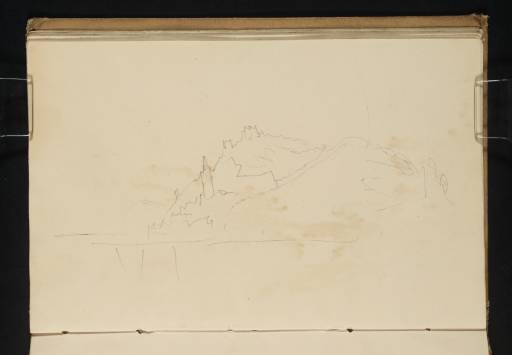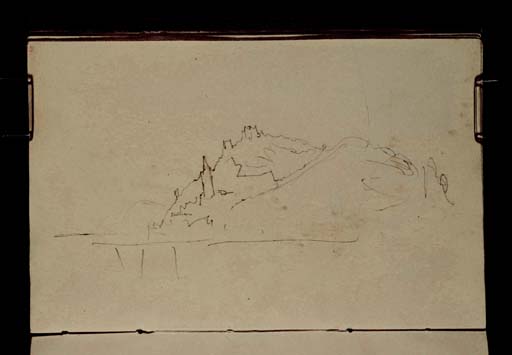Joseph Mallord William Turner Donaustauf, with St Michael's Church, the Castle Ruins, and the Bridge over the River Danube 1840
Image 1 of 2
Joseph Mallord William Turner,
Donaustauf, with St Michael's Church, the Castle Ruins, and the Bridge over the River Danube
1840
Joseph Mallord William Turner 1775–1851
Folio 33 Verso:
Donaustauf, with St Michael’s Church, the Castle Ruins, and the Bridge over the River Danube 1840
D31341
Turner Bequest CCCX 33a
Turner Bequest CCCX 33a
Pencil on cream wove paper, 126 x 198 mm
Partial watermark ‘atman’
Partial watermark ‘atman’
Accepted by the nation as part of the Turner Bequest 1856
References
1909
A.J. Finberg, A Complete Inventory of the Drawings of the Turner Bequest, London 1909, vol.II, p.998, CCCX 33a, as ‘Buildings on hill’.
1995
Cecilia Powell, Turner in Germany, exhibition catalogue, Tate Gallery, London 1995, pp. 70, 82 note 53, 168 under no.97, p.243, as ‘Donaustauf and its castle, with the bridge over the Danube’.
As recognised by Cecilia Powell,1 this horizontal view is north-west to Donaustauf from the bend of the River Danube, with the spire of St Michael’s Church and the ruins of the hilltop castle beyond the old bridge. The small town stands in quiet countryside on the north bank of the River Danube about five miles east of the centre of Regensburg (see under folio 18 verso; D31311), where Turner stayed at a hotel. For him, Donaustauf’s main attraction was the Greek temple-style Walhalla monument, nearing completion on its complex stone infrastructure high on the slopes above the river less than a mile east of the town, not far out of sight to the right of this view.
Usually rendered as ‘Valhalla’ in English, the mythical hall of Norse gods and heroes would later feature in Wagner’s operatic Ring cycle. In 1840 the German states still awaited unification as a nation in 1871; meanwhile King Ludwig I of Bavaria (ruled 1825–1848) had been planning a Hall of Fame to commemorate prominent Germans since the events of the Napoleonic War had stirred feelings of Romantic nationalism. Marble busts of royal, military, scientific, literary and artistic figures had already been in preparation for many years when building commenced in 1830, and by the time of Turner’s visit the building was nearing completion ahead of its opening in October 1842. Additions are still made to the pantheon from time to time. The Walhalla was designed in the Doric order by the Neo-Classical architect Leo von Klenze, and closely modelled on the Parthenon of Athens.2
There are further drawings of Donaustauf, the adjacent pilgrimage church of St Salvator and the Walhalla, in various combinations and from numerous viewpoints, on folios 34 recto–38 recto, the rectos of folios 41–43, folios 43 verso, 44 recto and 67 verso, the rectos of folios 68–70 and folio 70 verso, as well as inside the front and back covers, and probably the outside of the back cover too (D31342–D31350, D31356, D31358, D31360–D31362, D31409–D31410, D31412, D31414–D31415, D41400–D41402). In the early part of this sequence, all but this page, D31344, D31346 and D31348 include the Walhalla itself. Those from D31409 onwards comprise or include slight studies of architectural details rather than views of its landscape setting, except D31412, which includes both aspects. There are also pencil and chalk studies on separate sheets of grey paper (Tate D34084–D34085, D34093; Turner Bequest CCCXLI 363, 364, 371), the first of which shows the interior, apparently with some sculptures already in place.3 Tate D30020 (Turner Bequest CCXCIX 10) in the Trieste, Graz and Danube sketchbook, includes a thumbnail sketch of Donaustauf among quick reference copies from existing prints, likely made in Vienna, earlier on this tour.
Perhaps dating from a while after the tour, Tate D36174 (Turner Bequest CCCLXIV 316) is an atmospheric ‘colour beginning’-type watercolour,4 likely made in connection with the only finished composition to result from these extensive studies, a large painting of The Opening of the Wallhalla [sic], 1842 (Tate N00533),5 shown at the Royal Academy in 1843 and in Munich in 1845. There, the building features as a relatively minor, distant element and the foreground figures and setting seem largely symbolic of peace and harmony rather than an attempt at documenting the formal ceremonies.6 Ian Warrell has discussed the watercolour along with technically similar sheets showing Regensburg subjects relating to other pencil studies in this sketchbook;7 see the Introduction.
Matthew Imms
September 2018
How to cite
Matthew Imms, ‘Donaustauf, with St Michael’s Church, the Castle Ruins, and the Bridge over the River Danube 1840 by Joseph Mallord William Turner’, catalogue entry, September 2018, in David Blayney Brown (ed.), J.M.W. Turner: Sketchbooks, Drawings and Watercolours, Tate Research Publication, December 2019, https://www


